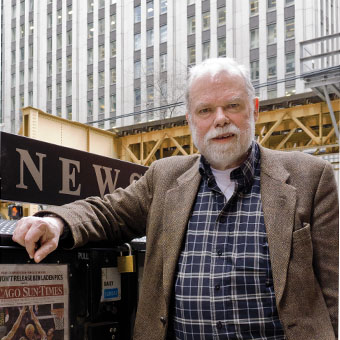The editors interview Jim Forest, biographer and friend of Dorothy Day–and a former Catholic Worker himself, about Dorothy Day’s abortion, conversion to Catholicism, and what she might think about women’s ordination.
How did Dorothy Day become Catholic?
One of the events in the background was that Dorothy had had an abortion when she was a young woman. Her partner, a journalist with whom she was passionately in love, enjoyed having his sex life with her but wasn’t at all interested in having children or being married. Desperately trying to save her relationship with the man, very reluctantly Dorothy decided to have an abortion. It seemed the only solution, but he left her anyway. Soon after, she attempted suicide.
Dorothy thought she had been made sterile by the abortion and, several years later, was amazed when, having fallen in love a second time, she became pregnant by the man she was living with. This seemed to her a miracle. This time she was determined that she would not have an abortion, despite the fact that her partner wanted her to.
That was really the beginning of her conversion, though for years she had been inching her way little by little to the Catholic Church in a mysterious way. She just felt comfortable in Catholic churches and would go and sit in the back and enjoy being in a place where the warmth of prayer was occurring, where the Blessed Sacrament was reserved. She wasn’t especially interested in the catechism or in Catholic teaching at that point in her life, but there was something like the smell that pulls you into the bakery shop that drew her.
When she discovered that she was pregnant — for her a capital-M Miracle — she realized the one thing that she wanted most of all for her daughter was to have the faith that she longed for herself.
She was in the neighborhood in Staten Island where she was then living, happened to see a nun, and she walked across the street to say, “I’d like to have my daughter baptized — what do I need to do?” And this no-nonsense Sister of Mercy said, “Well, I’ll give you instruction.” She visited Dorothy’s beach cottage regularly and they worked their way through the Baltimore Catechism. Not the most inspiring book!
Tamar was baptized soon after she was born, Dorothy’s partner found this intolerable. The Catholic Church was high on his list of things wrong with the world. It became the breaking point in their relationship. After their final break she was herself conditionally baptized — conditional because, as a child, she had been baptized in the Episcopal Church.
Did Day ever talk about her abortion?
She had very deep feelings about it, great distress. She didn’t want anybody to know about it. I didn’t know about it until after she was dead.
As a Catholic Dorothy stood for what Cardinal Bernardin called a “consistent pro-life ethic.” That means you do all you can to preserve life, no matter whose, no matter at what age — unborn children, old people who are suffering from dementia, and everybody in-between. But, having had an abortion herself, she wasn’t self-righteous about it. There was a great deal of compassion. She’s at least as much a challenge to the pro-life movement as she is to the pro-choice movement. Dorothy knew that many women have abortions because they feel abandoned, they are in despair, they feel trapped, terrified, they feel alone and feel they have no alternative. Dorothy had been there and knew what it was like. She did what she could not by scolding but by caring and offering a helping hand.
Many think of Dorothy Day as the patron of progressive, “social justice” Catholics. How would she feel about that?
Dorothy was in some ways a very conservative Catholic. It wasn’t that she was a non-critical Catholic. She used to sometimes say that when St. Peter cast his nets into the sea to become a fisher of men, he caught a number of sharks, blowfish and barracuda. She would write about what she called business-like priests who are not at all interested in social justice. She would describe the church as “the cross on which Christ was crucified.” She didn’t romanticize the church; she just said the church is where she met the body of Christ in all of his woundedness and brokenness
I remember a priest coming down to celebrate Mass at the Catholic Worker one day. He either forgot to bring a chalice and paten with him or just decided that he would do something to integrate the Catholic Worker and the Eucharist more. So he used a coffee cup and a sandwich plate.
I’m sure Dorothy received the Eucharist with her usual gratitude — but noticed afterwards that she took the cup and the saucer out into the garden behind the house and buried them because they should not be returned to their previous use.
So in that sense she was a “conservative” Catholic, but I don’t know if that’s a good adjective. She had a very strong sense of some things being set aside for the sacramental life of the church. I know the priest was a little chastened by that experience.
Is there anything about Dorothy’s Catholicism that might shock her admirers?
One thing I can say with a pretty high degree of confidence is Dorothy would not be in favor of the ordination of women to the priesthood. She said if women are ordained, fewer men would attend the liturgy, and there are few enough already! It was very non-theological.
Dorothy had quite a vivid idea of the difference between men and women, and she thought of them as having complementary but not identical or interchangeable roles. It’s interesting to read what she writes about the differences, for example, between herself and Peter Maurin, the co-founder of the Catholic Worker. Her experiences of men had convinced her that men tend to be more abstract, more in the future tense, and that women are glued to reality in a way that many men are not, that women’s lives are very much in the present tense.
Whether this is valid or not, I don’t know, but it was something very clearly in Dorothy’s mind that she expressed it from time to time in various ways. I think she would be still irritating to some people in the Catholic Worker movement when she got onto these kinds of topics. She wasn’t someone who diplomatically avoided anything.
This is a web-only feature that accompanies the editors’ full interview with Jim Forest in the November 2011 issue of U.S. Catholic (Vol. 76, No. 11, pages 18-21).
Image: Photo of Jim Forest by Tom Wright













Add comment